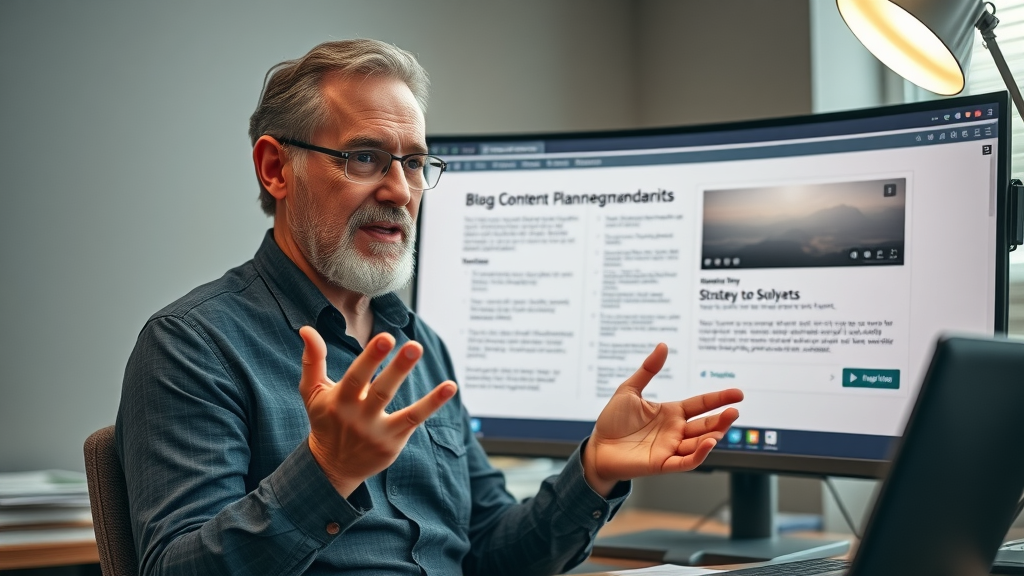Hook: Have you ever wondered why some blogs seem to soar in traffic year after year while others struggle to gain traction? The secret isn't just in their writing—it's in their strategy. Content planning for blogs is the difference-maker that turns sporadic pageviews into sustained audience growth. This comprehensive guide unpacks how the right plan can turn your blog into a traffic powerhouse.
Are You Struggling to Achieve Consistent Traffic? Discover How Content Planning for Blogs Can Transform Your Results
If you find yourself frustrated with unpredictable blog traffic, you’re not alone. Many bloggers pour hours into writing, only to see fleeting bursts of interest. The key problem often isn’t the quality of your content—rather, it’s the absence of a blog content strategy . Content planning for blogs empowers you to map out your blog posts in advance, align them with your goals, and address the pain points your target audience faces. With a solid plan, each blog post contributes to your long-term success, rather than getting lost in the digital noise.
By consistently analyzing what works and strategically scheduling future topics, you build momentum that translates into dependable, growing traffic. Whether you’re an experienced content marketer or just starting to create content , leveraging content planning will not only streamline your content creation process but also ensure every blog post idea serves a clear purpose. Practical tools like a content calendar make it easy to stay ahead of deadlines and outshine competitors. Read on to learn actionable steps, see real-world examples, and access must-have templates that can ignite your traffic growth journey.

Why Content Planning for Blogs is the Key to Long-Term Blog Growth
Understanding the power of content planning for blogs reveals why leading blogs don’t leave success up to chance. Instead of scrambling for each new blog post idea , smart bloggers establish a clear content plan mapped to their overall blog goals. This approach ensures every post is both relevant and timely, ultimately building a loyal readership. A robust blog content strategy eliminates rushed, off-topic posts and creates consistency essential for SEO, reader engagement, and authority in your niche.
With a dedicated content calendar as part of your content creation workflow, every media post , whether a blog, video, or social media update, fits seamlessly into your traffic-driving strategy. Over time, this discipline compounds; you’ll experience more organic shares, improved search engine rankings, and sustainable website growth. In the following sections, we’ll explore practical insights for setting up your content plan and fine-tuning your blog content strategy .
- Gain practical insights into content planning for blogs , from establishing a content plan to perfecting your blog content strategy for sustained engagement and growth.
- Discover how structured content keeps your audience engaged and positions your blog as an authority in your niche.
- Explore tools, templates, and creative workflows that make content planning efficient—even for busy teams.
Understanding Content Planning for Blogs: The Foundation of a Winning Content Strategy

Defining Content Planning for Blogs: Setting the Stage for Success
Content planning for blogs refers to the proactive process of mapping out what, when, and why you’ll publish blog content . Rather than reacting to ideas as they arise, you develop a clear content plan anchored by your audience’s needs and your blog’s objectives. This approach goes far beyond brainstorming, encompassing content audits, keyword research, seasonal themes, and even collaboration within your marketing team .
By setting the stage with a deliberate plan, you transform sporadic inspiration into reliable execution. Not only does this give clarity to your creation process , but it also creates opportunities to optimize for search engine traffic, increase engagement through social media posts , and build authority via regular publishing. Effective content planning is the backbone of any winning blog content strategy .
Key Components of a Successful Blog Content Plan
A strong content plan for blogs includes several key components that together drive consistent results. First, it starts with a clear content strategy—an overarching vision for your blog’s purpose, themes, and audience. Next comes the identification of content clusters: organizing topics into interconnected themes that establish your site’s expertise and make it easier for readers (and search engines) to navigate.
A functional content calendar is vital, acting as your visual hub for all scheduled blog posts, deadlines, and publishing dates. This is supported by a reliable editorial workflow, which tracks each stage of content creation from idea to publication. Lastly, regular review and data-driven optimization ensure your plan evolves to meet changing audience needs and competition.
| Ad-Hoc Posting | Strategic Content Planning for Blogs |
|---|---|
| Last-minute blog post ideas, often missing deadlines | Consistently executed blog posts aligned with strategy |
| Inconsistent topics and messaging | Unified themes and messaging for strong brand recall |
| Low audience engagement due to lack of anticipation | Higher engagement, anticipation, and audience trust |
| Lack of tracking for performance or SEO | Data-driven, SEO-optimized approach with measurable outcomes |
"A well-crafted content plan empowers bloggers to deliver meaningful, timely, and impactful blog content—ensuring each post serves a purpose."
Crafting an Effective Content Plan: Step-by-Step Blueprint for Content Planning for Blogs

How to Align Your Content Strategy with Business Goals
Connecting your content to overall business goals is the foundation of any high-impact content plan . Begin by clarifying your blog’s purpose: Do you want to drive leads, build authority, or help customers solve specific problems? Next, map your content strategy to these outcomes. For instance, if you’re aiming for lead generation, plan blog posts around pain points your ideal customer faces—each post nudges readers toward your product, service, or offer.
Engage your marketing team or stakeholders early, setting clear expectations and defining measurable KPIs. By aligning every piece of blog content with business priorities—from brand voice to call-to-action placement—you avoid wasted effort and maximize your marketing efforts . Ultimately, a content strategy that reflects business needs ensures your blog is not only creative but also profitable and impactful in the long term.
Utilizing a Content Calendar for Blogs: Staying Ahead of Deadlines

The content calendar is the engine that keeps content flowing on schedule. Start by listing all your post ideas—those “aha!” moments or well-researched content ideas should be documented, then mapped out by date and priority. A well-maintained calendar prevents last-minute scrambles, allowing for smarter time management and more polished posts.
Use a digital tool or template where you can easily drag-and-drop content, assign tasks to each team member , and track progress toward deadlines. Remember to build in flexibility to accommodate trending topics or sudden industry news. The visibility a content calendar brings enables you to plan social media posts in tandem, further amplifying the reach of each blog post .
Integrating Social Media and Blog Content to Amplify Reach

To maximize impact, integrate your blog content strategy with your social media calendar. When you publish a new blog post , break it into compelling snippets for social media posts , linking back to your blog. This increases visibility, invites discussion, and harnesses the viral potential of digital sharing.
Involve your marketing team or content marketer when crafting these plans. Coordinate your messaging, visuals, and posting schedules across platforms like Instagram, LinkedIn, Twitter, and Facebook. This synergy amplifies each blog post , reaches broader audiences, and keeps your brand top-of-mind. Don’t just promote—engage: ask questions, encourage comments, and repurpose posts based on the responses you see.
Keyword Research in Content Planning for Blogs: Finding Topics That Resonate
Effective content planning for blogs always includes keyword research —the process of identifying what your audience is actively searching for. Use search engine tools to analyze trends, check competitors, and discover long-tail keyword opportunities that match your expertise and audience needs. Keyword research guides your editorial direction, revealing gaps where your blog can provide unique, valuable insights.
Don’t just focus on high-volume terms; look for strategic niches and pain points you can address better than anyone else. Incorporating research-backed content ideas into your plan helps drive targeted, organic traffic, ensuring your effort pays off both in engagement and SEO value.
Create a Content Plan That Works: Tools, Templates, and Workflow
Choosing the Right Content Calendar Software for Blog Content Planning

Selecting the right software can make or break your content plan . Tools like Trello, Asana, Notion, and Google Calendar offer flexible scheduling, visual tracking, and team collaboration—all essential features for professional content planning for blogs. Evaluate each tool by how intuitively you can create and update your content calendar , assign deadlines, and monitor progress with every blog post .
Robust content planning software should allow you to attach documents, links, and briefing notes to each calendar entry, and ideally, integrate with other marketing campaigns or social media scheduling tools. Choose a tool that matches your workflow: solo bloggers might prefer simplicity, while a team setup requires advanced collaboration options.
Developing an Editorial Workflow for Consistent Blog Posts
Establishing a systematic editorial workflow is the backbone of consistent content creation. Start by defining roles for each team member : ideation, writing, editing, graphics, SEO, and publishing. A shared editorial checklist ensures every blog post meets your quality standards and aligns with the overall blog content strategy .
Instituting review rounds and digital approvals reduces the risk of missed steps. Set up automated reminders so deadlines aren’t forgotten and flesh out a repository of post ideas for quick reference. Streamlining this process lets you deliver new blog posts on time, every time—no matter who’s on vacation or facing writer’s block.
- Checklist: Must-Have Elements for a Robust Blog Content Strategy
- Clear definition of target audience and goals
- Documented content themes and clusters
- Systematic keyword research
- Detailed content calendar with deadlines
- Streamlined editorial workflow
- Integration plan for social media amplification
- Analytics tracking and regular content audits
Optimizing Content Planning for Blogs: Target Audience, SEO, and Content Ideas

Defining Your Target Audience for Strategic Blog Content
Every successful blog content strategy is rooted in a deep understanding of its target audience . Start by building personas based on user demographics, interests, and pain points. Identify the biggest challenges your readers face and tailor each blog post to address these needs in detail.
By speaking directly to your target audience, you boost relevance and engagement, increasing the odds that each blog post or media post will be shared, bookmarked, and revisited. Continually refine these personas by collecting feedback, running surveys, and analyzing engagement metrics to guide your evolving content plan .
Generating Impactful Content Ideas for Your Content Plan
Strong content planning for blogs revolves around generating a steady stream of impactful content ideas . Research top industry trends, monitor competitor blogs, and brainstorm with your marketing team to curate a long list of potential post topics. Use customer questions, keyword research tools, and social listening to identify timely topics and pain points.
Organize potential topics into content clusters—groups of related blog posts that support overarching themes for your site. Prioritize your content ideas by their potential for engagement, SEO impact, and alignment with business goals, then schedule them in your content calendar .
On-Page SEO and Keyword Optimization in Blog Content Planning
Optimizing for SEO is a non-negotiable step in successful content planning for blogs . Each blog post should target specific, well-researched keywords that match your target audience ’s search queries. Start by integrating your primary keyword into the post title, first paragraph, headers, and naturally throughout the text.
Go further by optimizing meta descriptions, image alt-tags, and internal links to related posts. Regularly conduct a content audit to identify old posts that can be updated for today’s SEO standards. By focusing on keyword-rich, high-value content, your blog will steadily climb the search engine rankings and attract ongoing organic traffic.
Measuring Results: Analytics That Matter in Content Planning for Blogs
The effectiveness of your content planning hinges on how well you track and analyze results. Monitor KPIs such as page views, time on site, bounce rate, social shares, and conversion rates for each blog post . Google Analytics, Search Console, and dashboard tools can help visualize performance trends and reveal which topics deliver the highest ROI for your content plan .
Use regular data reviews to refine your blog content strategy , doubling down on what works and shifting gears when needed. A data-driven plan helps ensure you’re serving your target audience with valuable, engaging content every month.
| Week | Content Theme | Blog Post Title | Keyword Focus | Social Media Post Date |
|---|---|---|---|---|
| 1 | SEO Fundamentals | How to Begin Keyword Research | keyword research, content planning | Monday |
| 2 | Audience Growth | Building Personas for Your Blog | target audience, blog content | Wednesday |
| 3 | Blog Monetization | Monetizing Blog Posts Efficiently | blog posts, monetization | Friday |
| 4 | Engagement Boost | Content Ideas to Engage Readers | content ideas, engagement | Monday |
Advanced Strategies for Content Planning for Blogs: Scaling Up

Coordinating with Marketing Teams and Content Marketers
Scaling up your content planning for blogs requires syncing efforts across multiple departments. Align your marketing team, writers, designers, and even customer support to ensure everyone is working toward common goals. Hold regular strategy meetings to share insights, brainstorm content ideas , and resolve any workflow bottlenecks.
Lean into your content marketer’s expertise to optimize your content assets for different stages of the funnel, from awareness-building posts to conversion-driven guides. Collaboration fosters innovation and ensures every blog post delivers measurable value in your overall marketing plan .
Multi-Channel Content Strategy: Uniting Your Blog Content with Social Media
A true multi-channel approach connects your blog content strategy directly with your overall digital marketing efforts. Consider each blog post as a central asset to be repackaged across email, video, podcasts, and various social media platforms.
Develop a matrix that maps each piece of content to multiple distribution channels, leveraging a consistent message while tailoring the format to each platform’s unique audience. This unity between blog and social media posts amplifies both your visibility and your authority across your entire digital presence.
Continuous Improvement: Updating Your Blog Content Plan Based on Performance
Content planning for blogs is a dynamic, living process—constant improvement is key. Regularly review the analytics for your content calendar, identifying high-performing and underperforming post types. Refresh your strategy with updated keyword research, address new audience pain points, and create fresh blog post ideas to stay ahead of industry trends.
Encourage your team to contribute feedback and suggest improvements to your editorial workflow. Every iteration brings greater efficiency and effectiveness, allowing your content plan to scale as your blog, traffic, and team evolve.
"Content planning is a living process—refine your approach with each blog post, and long-term traffic will follow."
Video: Visualizing Content Planning for Blogs – Building Your First Content Calendar
This step-by-step video walks you through collecting content ideas, conducting keyword research, and organizing your first content calendar using modern digital tools. Learn best practices visually so you can build an efficient publishing process from day one.
Video: How to Research and Organize Blog Content Ideas for Seamless Execution
Explore how to brainstorm, refine, and structure blog post ideas into actionable calendars for flawless execution using smart strategies and collaboration.
Expert Insights on Blog Content Planning

"The foundation of a strong blog content strategy is a powerful content plan, supported by actionable insights and continuous optimization."
People Also Ask: How to Plan Content for a Blog?
A Comprehensive Guide to Planning Content for a Blog

Begin by setting your blog’s objectives—whether you want to inform, persuade, or entertain your audience. Conduct detailed research to understand your target audience and identify topics that genuinely resonate with them. Start gathering post ideas from keyword research, social media trends, and the questions people ask your business.
Next, organize your content ideas into clusters or themes to keep your blog focused and authoritative. Use a content calendar to schedule each blog post and assign clear deadlines. Finally, regularly update your plan to reflect analytics, seasonal topics, or industry shifts to stay relevant and effective.
Step-by-Step: Setting Content Goals, Researching Topics, and Designing a Content Calendar
1. Define clear content goals for your blog. 2. Research and validate topic ideas using keyword research tools. 3. Group topics into themes or clusters. 4. Map your publishing schedule with a content calendar. 5. Assign roles and deadlines using editorial workflow tools. 6. Review, publish, promote, and monitor content performance. 7. Adjust the plan monthly based on analytics.
People Also Ask: What is the 80/20 Rule for Blogging?
Exploring the 80/20 Principle in Content Planning for Blogs
The 80/20 rule , also known as the Pareto Principle, posits that 80% of your blog traffic will come from just 20% of your blog posts . When applied to content planning for blogs , this principle advises you to focus on those critical posts and content ideas that drive the most engagement, shares, backlinks, and conversions.
Pinpoint your highest-performing content through analytics and devote extra time to enhancing, updating, and promoting these core posts. This focused approach streamlines your blog content strategy and maximizes your returns for the same effort.
How Focusing on Top Content Ideas Drives 80% of Blog Traffic
By prioritizing evergreen, high-value blog post ideas in your content plan , you set your blog up to attract the lion's share of organic traffic month after month. Identify which posts convert readers, spur discussion, or consistently draw links, and place these at the heart of your calendar.
Refresh these posts regularly and create supporting content clusters that link back to them, further boosting SEO and visibility. This strategy transforms your blog into a consistent traffic generator.
People Also Ask: What are the 7 Steps in Creating a Content Strategy?
The 7 Essential Steps to Developing a Winning Blog Content Strategy
1. Define your audience and blog goals. 2. Conduct competitive and keyword research. 3. Map out content themes and clusters. 4. Build a content calendar with timelines. 5. Assign responsibilities and design workflows. 6. Execute, publish, and promote content. 7. Measure performance and continuously optimize.
Applying Each Step to Your Own Content Planning for Blogs
Tailor each step to fit your resources and niche. Use the insights gained from audience surveys and analytics to shape goal-oriented themes. Employ keyword research to drive your topic selection and validate content ideas that solve real-world problems for your community.
Refine your workflows as your blog evolves, and always close the loop by iterating on your strategy based on measurable results.
People Also Ask: How Do I Organize My Blog Content?
Effective Techniques for Organizing Blog Content for Maximum Engagement
Categorize your blog posts by themes or clusters, use tags for improved navigation, and create clear editorial guidelines to maintain quality and voice across all content types. Set up an archive or resource library for your best evergreen content ideas.
Catalog your content ideas and performance analytics in a shared workspace like Notion or Airtable, ensuring all team members can access and contribute to the planning process.
Using Tools and Templates to Streamline Your Blog Content Plan
Pre-designed templates for content calendars, editorial checklists, and brainstorming sheets take guesswork out of content planning. Use digital tools for automation, deadline tracking, and collaboration, making your plan scalable and adaptable to new marketing efforts .
Templates not only save time but also ensure consistency, especially as your team expands or your publishing frequency increases.
Frequently Asked Questions on Content Planning for Blogs
- How often should you update your blog content plan? Ideally, review your content plan monthly. Refresh topics based on analytics, industry trends, or current events to keep your blog relevant and effective.
- What tools automate content planning for blogs? Tools like Trello, Asana, Notion, and Editorial Calendar plugins automate scheduling, reminders, and workflow for bloggers and teams of all sizes.
- How do you balance evergreen vs. trending blog content? Maintain a core of evergreen content for sustained traffic, while slotting in timely, trending topics to capitalize on seasonality and current interest.
Strategic Takeaways for Consistent Traffic Through Content Planning for Blogs
- Establish a clear content plan that reflects your blog goals and audience needs.
- Leverage a dynamic content calendar for organized, on-time publishing.
- Integrate your social media and blog content to expand reach and engagement.
- Emphasize data-driven adjustments for continuous growth and optimization.
Building a Future-Proof Content Plan: Where Consistency Meets Creativity in Blog Content
The winning blogs of tomorrow are being built today with powerful, flexible content planning. Embrace the process, harness smart tools, and unleash your creativity—consistency is the secret ingredient to sustainable traffic and blog growth.
To enhance your understanding of content planning for blogs, consider exploring the following resources:
- “Content Planning for Your (Growing) Blog: 6 Easy-to-Use Tips” ( yoast.com )
This article offers practical advice on developing a content strategy, creating an editorial calendar, and maintaining consistency, especially when collaborating with multiple authors.
- “How to Create a Content Strategy for Your Blog [10-Step Guide]” ( hostgator.com )
This comprehensive guide outlines a step-by-step approach to building a content strategy, including the importance of a content calendar and conducting SERP research for each post.
If you’re serious about elevating your blog’s performance, these resources will provide valuable insights and actionable steps to implement effective content planning strategies.
 Add Row
Add Row  Add
Add 




Write A Comment